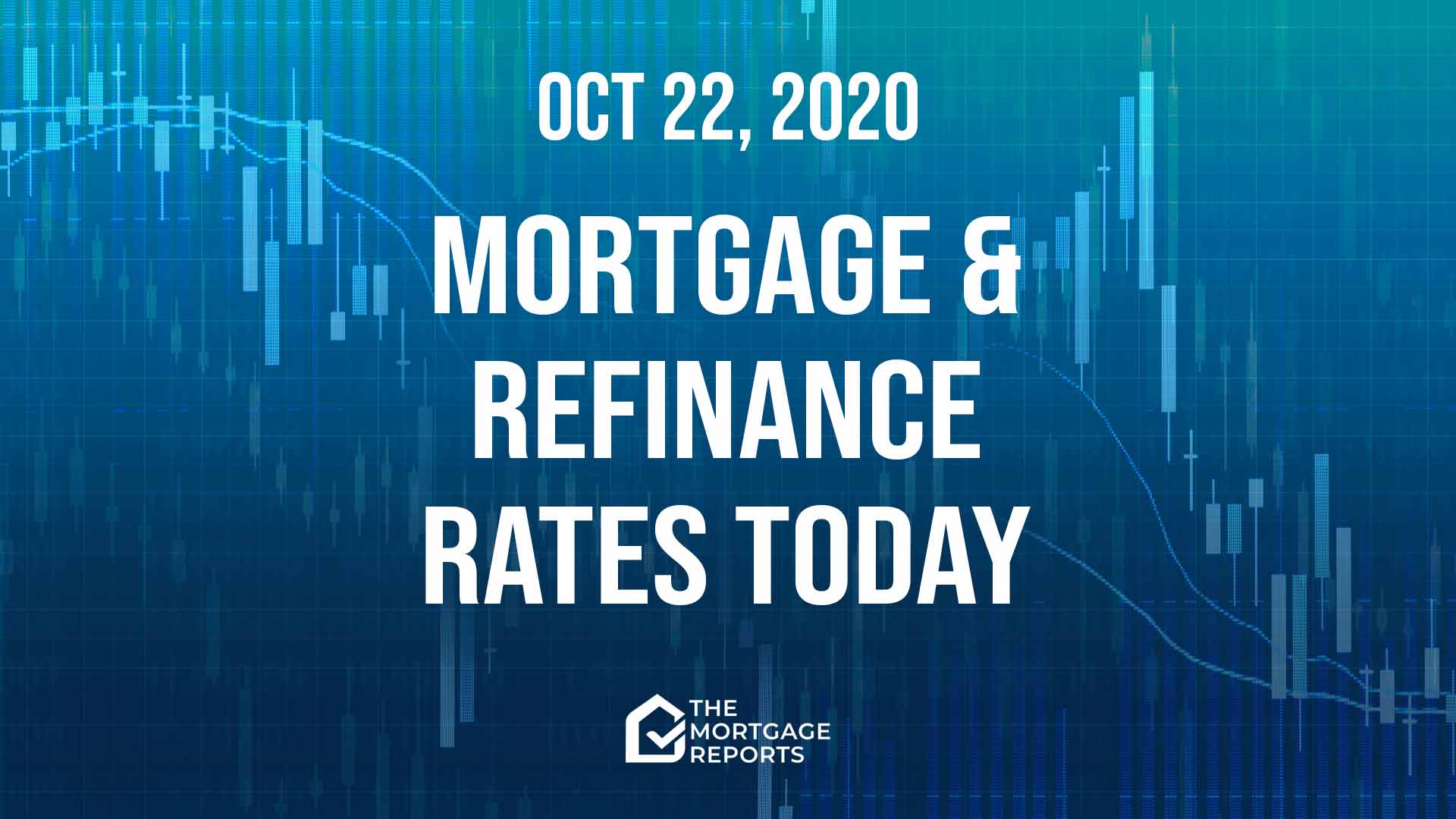
Today’s mortgage and refinance rates
Average mortgage rates edged higher yesterday. And conventional loans today start at 3.125% (3.125% APR) for a 30-year, fixed-rate mortgage.
Yesterday’s rise was mostly down to lingering hopes for an agreement over a preelection stimulus package. Will markets be able to maintain their optimism today with time so short?
Find and lock a low rate (Oct 22nd, 2020)Current mortgage and refinance rates
| Program | Mortgage Rate | APR* | Change |
|---|---|---|---|
| Conventional 30 year fixed | |||
| Conventional 30 year fixed | 3.125% | 3.125% | Unchanged |
| Conventional 15 year fixed | |||
| Conventional 15 year fixed | 3% | 3% | Unchanged |
| Conventional 5 year ARM | |||
| Conventional 5 year ARM | 3% | 2.743% | Unchanged |
| 30 year fixed FHA | |||
| 30 year fixed FHA | 2.25% | 3.226% | Unchanged |
| 15 year fixed FHA | |||
| 15 year fixed FHA | 2.25% | 3.191% | Unchanged |
| 5 year ARM FHA | |||
| 5 year ARM FHA | 2.5% | 3.245% | +0.01% |
| 30 year fixed VA | |||
| 30 year fixed VA | 2.938% | 3.115% | -0.13% |
| 15 year fixed VA | |||
| 15 year fixed VA | 2.25% | 2.571% | Unchanged |
| 5 year ARM VA | |||
| 5 year ARM VA | 2.5% | 2.426% | +0.01% |
| Your rate might be different. Click here for a personalized rate quote. See our rate assumptions here. | |||
Find and lock a low rate (Oct 22nd, 2020)
COVID-19 mortgage updates: Mortgage lenders are changing rates and rules due to COVID-19. To see the latest on how coronavirus could impact your home loan, click here.
Should you lock a mortgage rate today?
Overnight, CNBC ran the headline, “Treasury yields edge lower as stimulus talks drag.” Mortgage rates often shadow the yield on 10-year Treasurys. So is that a good sign?
It may be. But everything depends on how those talks pan out. There may still be time for an agreement. However, there’s resistance in the US Senate. And it’s increasingly unclear whether it’s practicable to pass legislation within the 12 days left before Election Day.
Meanwhile, there are plenty of other things to worry investors. COVID-19 infection rates in the US continue to soar and death rates are tragically beginning to follow suit.
And unemployment remains stubbornly high. Yes, this morning’s weekly claims for new unemployment insurance came in at 767,000. And that’s the lowest since March. But it’s still painfully high for an economy that’s supposed to be in recovery.
Still, it might be enough to stop mortgage rates falling today. And if those stimulus talks do end in success, any rise could be appreciable.
Of course, there’s always danger from breaking news that lightens the mood in markets. So don’t gamble more than you’re prepared to lose on rates moving lower.
Still, my personal recommendations remain:
- LOCK if closing in 7 days
- LOCK if closing in 15 days
- FLOAT if closing in 30 days
- FLOAT if closing in 45 days
- FLOAT if closing in 60 days
But, with so much uncertainty at the moment, your instincts could easily turn out to be as good as mine — or better. So be guided by your gut and your personal tolerance for risk.
Compare top refinance lenders
Refine results by loan type:
Market data affecting today’s mortgage rates
Here’s the state of play this morning at about 9:50 a.m. (ET). The data, compared with about the same time yesterday morning, were:
- The yield on 10-year Treasurys edged up to 0.83% from 0.81%. (Bad for mortgage rates.) More than any other market, mortgage rates normally tend to follow these particular Treasury bond yields, though less so recently
- Major stock indexes were mostly modestly higher on opening. (Bad for mortgage rates.) When investors are buying shares they’re often selling bonds, which pushes prices of those down and increases yields and mortgage rates. The opposite happens when indexes are lower
- Oil prices nudged down to $40.58 from $40.96 a barrel. (Good for mortgage rates* because energy prices play a large role in creating inflation and also point to future economic activity.)
- Gold prices fell to $1,906 from $1,928 an ounce. (Bad for mortgage rates*.) In general, it’s better for rates when gold rises, and worse when gold falls. Gold tends to rise when investors worry about the economy. And worried investors tend to push rates lower.
- CNN Business Fear & Greed index held steady at 67 out of a possible 100 points. (Neutral for mortgage rates.) “Greedy” investors push bond prices down (and interest rates up) as they leave the bond market and move into stocks, while “fearful” investors do the opposite. So lower readings are better than higher ones
Before the pandemic and the Federal Reserve’s interventions in the mortgage market, you could look at the above figures and make a pretty good guess about what would happen to mortgage rates that day. But that’s no longer the case. The Fed is now a huge player and some days can overwhelm investor sentiment.
So use markets only as a rough guide. They have to be exceptionally strong (rates are likely to rise) or weak (they could fall) to rely on them. Today, they’re looking worse for mortgage rates. This morning’s unemployment numbers may be enough to push them a little higher. But it would likely take a deal over new stimulus measures to make a rise appreciable.
Find and lock a low rate (Oct 22nd, 2020)
Important notes on today’s mortgage rates
Here are some things you need to know:
- The Fed’s ongoing interventions in the mortgage market (way over $1 trillion) should put continuing downward pressure on these rates. But it can’t work miracles all the time. So expect short-term rises as well as falls. And read “For once, the Fed DOES affect mortgage rates. Here’s why” if you want to understand this aspect of what’s happening
- Typically, mortgage rates go up when the economy’s doing well and down when it’s in trouble. But there are exceptions. Read How mortgage rates are determined and why you should care
- Only “top-tier” borrowers (with stellar credit scores, big down payments and very healthy finances) get the ultralow mortgage rates you’ll see advertised
- Lenders vary. Yours may or may not follow the crowd when it comes to rate movements — though they all usually follow the wider trend over time
- When rate changes are small, some lenders will adjust closing costs and leave their rate cards the same
- Refinance rates are typically close to those for purchases. But some types of refinances from Fannie Mae and Freddie Mac are currently appreciably higher following a regulatory change
So there’s a lot going on here. And nobody can claim to know with certainty what’s going to happen to mortgage rates in coming hours, days, weeks or months.
Are mortgage and refinance rates rising or falling?
Over the last few months, the overall trend for mortgage rates has clearly been downward. A new all-time low was set early in August and we’ve gotten close to others since. Indeed, on Oct. 15, Freddie Mac said that a new low was set that week.
But certainty is in very short supply at the moment. So don’t assume anything.
It all depends on countless variables, most of which are unknowable.
Expert mortgage rate forecasts
Looking further ahead, Fannie Mae, Freddie Mac and the Mortgage Bankers Association (MBA) each has a team of economists dedicated to monitoring and forecasting what will happen to the economy, the housing sector and mortgage rates.
And here are their current rates forecasts for the last quarter of 2020 (Q4/20) and the first three of 2021 (Q1/21, Q2/21 and Q3/21).
Note that Fannie’s (out on Oct. 19) and the MBA’s (Oct. 21) are updated monthly. However, Freddie’s are now published quarterly. Its latest was released on Oct. 14.
The numbers in the table below are for 30-year, fixed-rate mortgages:
| Forecaster | Q4/20 | Q1/21 | Q2/21 | Q3/21 |
| Fannie Mae | 2.9% | 2.8% | 2.8% | 2.8% |
| Freddie Mac | 3.0% | 3.0% | 3.0% | 3.0% |
| MBA | 3.0% | 3.1% | 3.1% | 3.2% |
So predictions vary considerably. You pays yer money …
Find your lowest rate today
You can save literally thousands by comparison shopping for your mortgage or refinance across multiple lenders. So don’t cut your own throat by just going with one, no matter how well you know it or how highly it’s recommended.
You need to find your best deal possible. And that can change from lender to lender and from day to day.
That advice is especially important now. Some mortgage companies have withdrawn certain products or amended their offerings in response to the pandemic. And you may have to shop around to find a good deal on a cash-out refinance, a loan for an investment property, a jumbo loan or if your credit score is damaged.
So be prepared to kiss a lot of frogs in order to find your lender prince — or princess.
Verify your new rate (Oct 22nd, 2020)
Compare top refinance lenders
Refine results by loan type:



